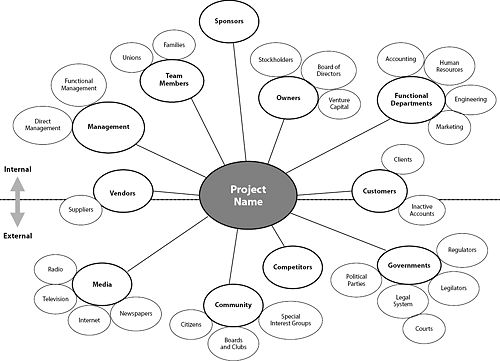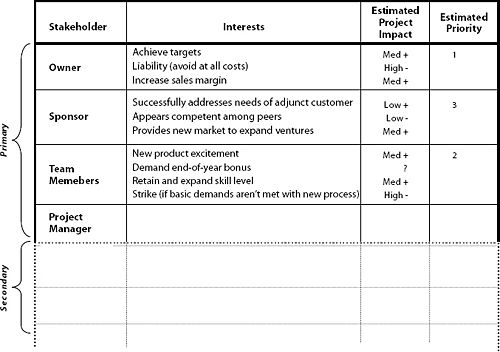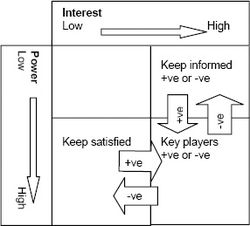Project Stakeholder Management
Editing in process - Sasha Mantel
Contents |
Abstract
According to the Project Management Institute (PMI), project stakeholder management is defined as "the processes required to identify the people, groups or organizations that could impact or be impacted by a decision, action or outcome of the project, and to analyze stakeholder interests, relationships and potential impact on project success." This article goes trough the different aspects of this definition, and then identifies why effective project stakeholder management is critical to the success of a project as it helps to build support, ensure alignment with stakeholders, and manage potential risks and challenges.
Moreover project stakeholder management can be more challenging in the context of a public project, as public procurements for instance. In fact they often involve a wider range of stakeholders with diverse and conflicting interests. These stakeholders may include government agencies, local residents, businesses, environmental organizations, and community groups, among others. Stakeholders may have different opinions about the project goals and outcomes, and also concerns about the impact of the project on their community or environment. Additionally, the public nature of the project may attract greater scrutiny and media attention, increasing the pressure on the project team to manage stakeholder expectations and mitigate any negative impacts. It is given here proposals of lines of conduct in the management of actors on a public project.
Definition
History of stakeholder management theory [1]
The fatherhood of stakeholder management theory has largely been attributed to R. Edward Freeman with his book Strategic Management: A Stakeholder Point of View published in 1984. This new theory is born as an opposition to The Managerial View of the Firm or a The Production View of the Firm. But even according to Freeman, we owe the stakeholder theory to different movements and thinkers who inspired it. On one hand, the early advocates of a Stakeholder theory underlined the importance of the different people or group of people that affect or are affected by a company, after an industrial revolution that led to bigger and more complex company than the usual family business. Also, publications like King and Cleland in 1978 emphasized the responsibilities and moral obligations of a company towards their stockholders, managers, employees but also suppliers, distributors, supporting service organizations, and finally the public and their clients. Later on the word stakeholder was applied to several less traditional groups ("the community", "the public"). A stakeholder point of view appeared in strategic management literature:
For a long time, we have assumed that the views and initiative of stakeholders could be dealt with as externalities to the strategic planning and management process; as data to help management shape decisions, or as legal and social constraints to limit them. We have been reluctant, though, to admit the idea that some of these out-side stakeholders might seek and earn active participation with management to make decisions. The move today is from stakeholder influence towards stakeholder participation
Dill, 1975, cited in Freeman's book (1984)
First research papers on Project Stakeholder Management came in the late 2000s. At first they mainly looked for principles in Stakeholder management theory that relevant for project management (Drouin and Jugdev, 2013).
Definition and main principles
Project stakeholder management corresponds to the process of analyzing stakeholders, organizing communication and understand their expectations, interests and influence in a project. A formal definition of a stakeholder according to the Project Management Institute (1996) is: “individuals and organizations who are actively involved in the project, or whose interests may be positively or negatively affected as a result of project execution or successful project completion”. Project Stakeholder Management ensures that a project meets stakeholders expectations, taking into account that different stakeholders may have different expectations and definitions of project success.
Implication of stakeholders in the process of the project is essential for several reasons :
- A project needs resources, financial and non-financial, provided by stakeholders
- The stakeholders will establish the criteria to assess the success of the project
- They will be the ones directly of indirectly impacted (positively or negatively) by the project and its potential success
- A form of resistance from them can have a negative impact on the project
Examples of classic stakeholders included in a project are the project manager, the customer, team members within the performing organization, and the project sponsor. But a further analysis is necessary to define all the stakeholders and to understand their importance, expectations, possible resources,... This is the stakeholder analysis, first tool for a project stakeholder management process. It involves using various methods to identify and understand the needs and expectations of internal and external stakeholders both within and outside of the project environment.
Understanding Stakeholders trough analysis
The different types of stakeholders
Several differenciation has to be taken into account when a stakeholder analysis is performed :
- The stakeholders can be individual or groups,
- they can be impacted by the outcome of the project directly or indirectly,
- they can be implicated in the daily activities of a project or only contribute punctually or on a more general level
Some vocabulary is generally used to describe a stakeholder status within a project :
- Internal/External : Different definitions can be found, but on a general level the internal stakeholder participates actively in the project execution whereas an external one is mainly affected by the outcome of the project. Other definitions will emphasize that internal stakeholders are part of the organization that is responsible of the project. Examples of external stakeholders in a public sector project are national and local authorities, public goods, licensing and surveying organizations, research institutes, consulting firms, and private interest groups such as stockholders, union workers, and pressure groups. [2]
- A construction stakeholder is an individual (or group of individuals) who has a significant impact on the success of a project
Setting the importance and the influence
The most important when assessing the stakeholder landscape is too determine for each of them their interests, and the impact there might be if their interests were not met. After the different stakeholders has been identified and characterized, different tools and templates are available in order to assess their needs and power.
Interest and Impact Table
The idea behind a Interest and Impact table is to create a table with all identified stakeholders, their primary interests, the level of potential impact on the project if the interest is not met, and priority relative to other stakeholders. It's important to identify both stated and hidden interests. In the example the following annotations are used : (+) for positive, (-) for negative, or (?) for unknown, as well as (H) for high, (M) for medium, (L) for low, or (?) for uncertain impact levels. Finally prioritizing stakeholders interests can subsequently help in decision-making when not all objectives can be met, or at least not at the same time.
Interest and Power Matrix
This diagram allow the project stakeholder manager to have an overview of the influence and the importance of every stakeholders. For instance stakeholders in the high influence—high importance quadrant will be considered key stakeholders.
Stakeholder Management Plan
Setting stakeholder management goals and objectives
Developing communication and engagement strategies
Prioritizing stakeholders
Effectiveness of project stakeholder management
Measuring stakeholder satisfaction
Building support
Ensuring alignment with stakeholders
Managing potential risks and challenges
Project Stakeholder management in the context of a public project
Complex stakeholder landscape
implication of a wide range of stakeholders, each with their own interests, needs, and concerns
Political sensitivity
Large sums of public money, impact on local communities
Public scrutiny
intense public scrutiny that can lead to increases stakeholder expectations and heightened concerns
Conflicting interests
Time and resources constraints
Public procurement projects often operate under tight time constraints, which can make it difficult to allocate sufficient time and resources to stakeholder management + impact the ability of the project team to effectively manage stakeholders
Regulation and bureaucratic processes
increases the difficulty to respond to stakeholder concerns and feedback on time
References
- ↑ Eskerod, P., Huemann, M., & Savage, G. (2015). Project Stakeholder Management—Past and Present. Project Management Journal, 46(6), 6–14. https://doi.org/10.1002/pmj.21555
- ↑ Parnell, Driscoll and Henderson, 2011
Vogwell, D. (2003). Stakeholder management. Paper presented at PMI® Global Congress 2003—EMEA, The Hague, South Holland, The Netherlands. Newtown Square, PA: Project Management Institute.
Project Management – 2nd Edition Chapter 5 : Stakeholder Management. Adrienne Watt; Merrie Barron; Andrew Barron; Erin Palmer; and Jose Solera
Eskerod, P., Huemann, M., & Savage, G. (2015). Project Stakeholder Management—Past and Present. Project Management Journal, 46(6), 6–14. https://doi.org/10.1002/pmj.21555
Waris, et al. Stakeholder Management in Public Sector Infrastructure Projects. Journal of Engineering, Project, and Production Management 2022, 12(3), 188-201


